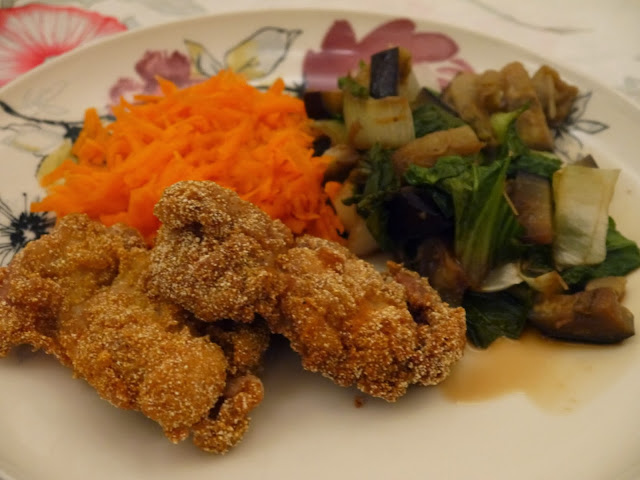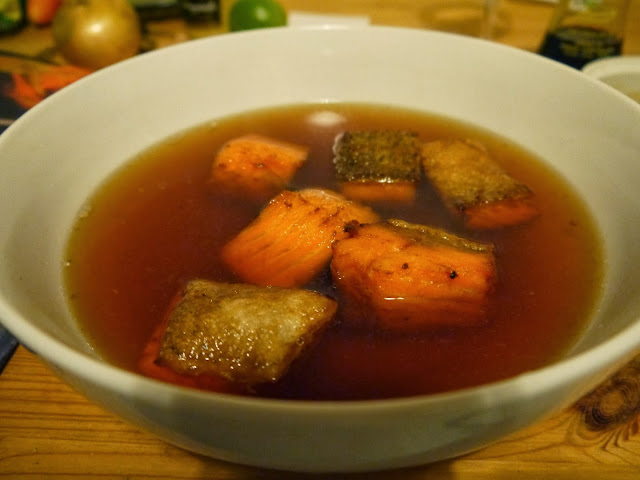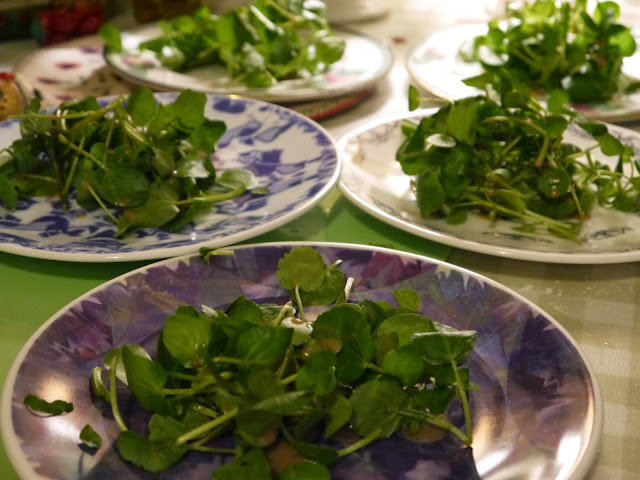It was actually Flo who first introduced me to Everyday Harumi - the essential Japanese cookery book that has fast become my favourite over the last few months. The principle of this book is that if you go to one specialist shop and buy a few Japanese store cupboard essentials, then you can just shop at regular supermarkets to get the rest as you go. There you have it, Everyday Harumi - every day.
I'd recommend this book as a great present for anyone who loves food let alone cooking. Nothing in it is hard to make and it opens up a whole new repertoire of flavours to your other cooking. Being a somewhat experimental chef, this is a wonderful experience for me - I have no idea what some dishes are going to taste like until they're done. It's good discipline!
Your store cupboard essentials:
Soy sauce
Dashi stock
Mirin rice wine vinegar
Sake (for cooking and for drinking)
Seaweed wraps
Good sushi rice
Here are my first 7 dishes, all cooked on school nights. Some on their own, some as accompaniments to other things. The measurements I use here feed 2 hungry people or three if you have a few things. Make one or two, or if you're feeling adventurous make all 7 for a Japanese dinner party.
Dish no. 1: Beef and Finely-shredded Vegetable Soup
For the beef:
200g thinly sliced beef
60-75ml soy sauce
1 tbs soy sauce
1-2 teaspoons caster sugar
For the soup:
50g carrots
70g celery
20g watercress (trimmed from the stems)
20g fresh ginger
1.2 litres of dashi stock (made from dashi stock powder or use Harumi's fish flake version in her opening chapter)
1 chilli pepper
You start by marinating your beef. Cut thinly sliced beef into 4-5cm long strips. Place in a bowl and add the soy, sugar, mirin and sake. Marinate for ten minutes whilst you prepare your soup ingredients. Slice your carrots, ginger and celery into julienne strips. Put your dashi stock into a large saucepan and heat until it comes to a gentle boil. At this point tip the contents of the marinating beef bowl into your pan. Skim the surface of any scum that forms. Add the carrots, celery, ginger and watercress in that order and simmer for a few minutes - the vegetables should still be crispy when serving.
Dish 2: Tender stem broccoli with a peanut and soy dressing
Ingredients:
Peanut butter
Soy sauce
Tenderstem brocolli
400g pork shoulder joint
Sunflower oil for frying
100ml soy sauce
50ml sake
1 tbs caster sugar
1/2 a leek
1 pieces of fresh ginger, peeled and lightly crushed
2 hard boiled eggs peeled
For the crepes
*I used my go-to crepe recipe here though Harumi has her own
To serve:
1 cucumber, 2 spring onions sliced into julienne and washed and dried
A small packet of mixed washed salad leaves
Chopped basil, mint and corriander to taste
Lightly brown the pork all over in the bottom of a heavy bottomed saucepan. Remove any excess oil in the pan with kitchen paper when done. Add the soy sauce, sake and sugar before pouring over just enough water to cover the pok. Add the stem of the leek and the ginger. Bring this mixture to the boil and then turn down to simmer, covering the pan with a dropped foil lid (see photos below for how to fashion yours).
Simmer for about 1 hour, skimming the surface regularly for scum - this is actually the pork fat rising to the surface so you're left with leaner meat. After 45 minutes of the hour are up, add the boiled eggs so that the surface has time to take on the colour of the broth but they don't over cook - they should end up golden brown. In your last 15 minutes, cook your crepes using the recipe of your choice.
When done, remove the pork and allow to rest before thinly slicing. Cut your eggs in half and arrange all the ingredients out on a table for guests to assemble for yourselves.
Dish 4: Deep Fried Chicken Thighs in a Leek Sauce
250g boneless chicken thighs - skin on
1/2 tbs soy sauce
1/2 tbs sake
a mixture of flour and polenta to coat your chicken (Harumi uses potato starch but I struggled to find this as easily)
sunflower oil
1/2 leek
50ml soy sauce
1/2 tbs sake
15ml rice vinegar
1/2 tbs caster sugar
1/2 sunflower oil
1/2 red chilli no seeds roughly chopped
Start by preparing your leek sauce. Stab your leek allover to tenderise it for chopping, then chop it as finely as you can. Mix together the soy sauce, sake, rice vinegar and sugar in a bowl. Lightly saute the leek and chilli in a frying pan - add the liquid and then when the sugar has dissolved, take it off the heat.
Marinade the chicken in the soy sauce and sake for 5 minutes. In the meantime, heat your oil. When the oil is hot, take each piece of chicken, coat it thoroughly and lower it into the pan. Allow to deep fry for at least 6 minutes, ensuring every piece is fully submerged. Remove the chicken and place on a wad of kitchen roll to remove the surface oil. Plate up or put into a serving bowl and pour the leek sauce over the top whist still steaming hot to serve.
Dish 5: Salmon Nanbanzuke
50g celery
40g peeled carrots
10g fresh ginger, peeled
1 red chilli
50g onion peeled
300g salmon fillets cubed into 3"x3" pieces
Salt and pepper to season
Plain flour to coat your fish
Sunflower oil for deep frying
1 lime sliced
For the Nanbanzuke Sauce
100ml dashi stock
35ml soy sauce
50ml rice vinegar
juice from 1/2 lemon
Start by making your bowl of Nanbanzuke sauce. You can serve your dish from this so use a serving bowl if deisred. Mix together your sauce ingredients and add salt as you wish. Chop the celery, carrots and ginger into julienne strips then finely slice both the chilli and the onion. Set aside.
Prepare the salmon by heating a few inches of oil in a saucepan - enough to cover your fish when deep frying. Then take each piece of fish and coat lightly in flour. When the oil is hot enough, drop the salmon pieces in, taking care not to splash. Allow these to deep fry for a few minutes until crispy on the outside but still a little underdone inside. Remove with a slotted spoon to drain excess oil, dab with kitchen paper if needs be, then place immediately into your nambanzuke sauce to marinade. Add the celery, carrot, ginger, chilli and thinly sliced lime to your bowl, cover and allow to marinate for at least half an hour before serving.
Dish 6: Green beans in a sesame dressing
This dish could not be simpler or more delicious.
50g sesame seeds
1 tbs soy sauce
1 tbs mirin
1 tbs white wine vinegar
1/2 tsp caster sugar
Place your sesame seeds into a pestle and mortar (or a food processor if you don't have one). Grind until a rough paste forms. Then add the rest of your ingredients and stir well.
Steam your green beans until a little crispy but cooked through, remove from the heat, run under cold water and pat dry. Put into a serving bowl and dress.


















































